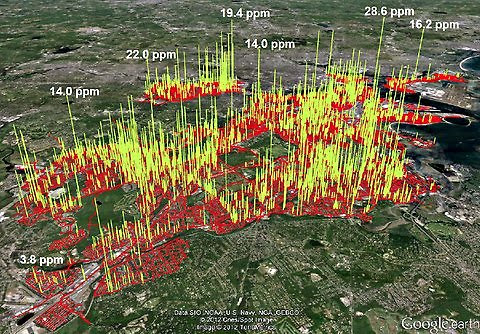Posted by: Francis Koster Published: September 16, 2015
This One Simple Trick Could Dramatically Cut Climate Change
This One Simple Trick Could Dramatically Cut Climate Change
by Francis P. Koster, Ed.D.
Local communities and major corporations both have an unrecognized chance to reverse the trends in climate change/global warming dramatically. This opportunity exists because according to the scientists one of the major gasses causing problems lives around 12 years[1]. If we can stop adding this one gas to the environment we could rather quickly see a slowing of the damage it causes.
Think of our environment like a campfire. If you want to make it burn slow and steady, you add wood on log at a time. If you want to make the fire burn explosively, you pour gasoline on it. If you don’t want to increase the flame, you stop adding gasoline, and the fire will simmer down.
The “gasoline” of climate change/global warming is leaking methane (natural gas) - and we can stop pouring into our atmosphere.
As the gas companies are fond of telling us, when burned in our homes, factories and power plants natural gas is only half as climate changing as coal. They are right - if the gas is burned.
However, if natural gas leaks from wells or pipes, it is between 150 and 200 times worse over its 12 year lifetime than burning coal![2],[3]
Stop the leaks and in 12 years things will begin to trend downward toward normal, and buy us some time to solve other difficult problems.
There are several different problem areas where leaks occur - leaking distribution systems, old and abandon wells, and cow farts.
In our country there are over 210 different major gas systems joined by 305,000 miles of big transmission pipelines, which feed 2,100,000 miles of pipes under America’s older city streets.[4],[5] Over the past 5 years, estimates of the leakage rates have soared as new leak detection equipment is put in place and as growing concern has led to more inspections. The most recent report[6] says that the leaks in parts of the system could be as much as eight times worse than previously believed.[7]Some number of the larger pipes have been replaced or repaired, but many of the millions of miles of smaller pipe were installed in the 1930’s and 1940’s still leak - a lot. Here is the results of one leak survey done by community activists in New York City.
 |
|
| Photo used with permission of DamascusCitizens.org - click here to go to full report and other images | Phillips, N.G., et al., Mapping urban pipeline leaks: Methane leaks across Boston, Environmental Pollution Journal (2012) |
One statement that one hears fairly often from the gas companies is some version of “Are you kidding me? Selling gas is how we make money…..do you think we would simply let it leak?” The other side of the aisle responds with some version of “Well, gas companies are allowed to include in your bills to customers lost and unaccounted for gas missing throughout the system, which removes some incentive”[8], and “You are in business to make money. If you have a large leak that is cheap to fix, the profit motive will see that it gets attention - but if you have lots of little leaks that are expensive to fix, the financial incentive works the other way.
Fortunately, new leak sealing techniques are being invented almost weekly. Unfortunately, they are not being used as much as they could be.
The most difficult problem to solve is old and abandoned wells, some dating back to the 1800’s. A 2014 Princeton University study found that between 28,000 and 970,000 abandoned gas wells exist just in in Pennsylvania alone. Scientists looked at a number of these, and found every abandon well inspected was leaking.[9]
Responsible parties may be long gone, or bankrupt.
Fixing this will probably require the creation of something similar to the Superfund program, a federal program created in 1980 to fix abandon toxic waste sites.About half of the states have programs that collect fees from drillers of new wells to plug abandon old and abandon wells, but the total amount collected is nowhere near the amount needed to solve the problem.[10]
Around two-thirds of all natural gas plumbing in the entire world is in the United States. If we all agree to fix all the leaks in our local area, and the major companies partner with the Environmental Protection Agency to fix the leaks at drilling sites and big pipelines, and plug the old and abandon wells, we can significantly reduce the global trend toward more violent weather, increase national food security, and keep our atmosphere pure.
There is good news on another front. Scientists have long reported that a good bit of the methane in the atmosphere is caused by cows passing gas. The good news is that in August of 2015 Penn State scientists announced that a modest change in cow food results in between 30% to 60% reduction in gas from this source.
The fact that we now know we can control this damage to our world presents us with a moral duty. It is time to walk our talk. And we need to get started - we don't have much time left.
[1]IPCC Fourth Assessment Report, Table 2.14, Chap. 2, p. 212
[2] Calculated from the 20 year life found in IPCC Fourth Assessment Report, Table 2.14, Chap. 2, p. 212
[3] IPCC Fourth Assessment Report, Table 2.14, Chap. 2, p. 212
[8] http://www.damascuscitizensforsustainability.org/2013/03/manhattan-natural-gas-pipeline-emissions-final-report/
[9] http://dataspace.princeton.edu/jspui/bitstream/88435/dsp019s1616326/1/
Kang_princeton_0181D_10969.pdf
Copyright © 2020 The Optimistic Futurist. All Rights Reserved.
Francis P. Koster Ed.D.
Proven local solutions to national problems.
CONTACT
Copyright © 2023 America's Optimistic Futurist